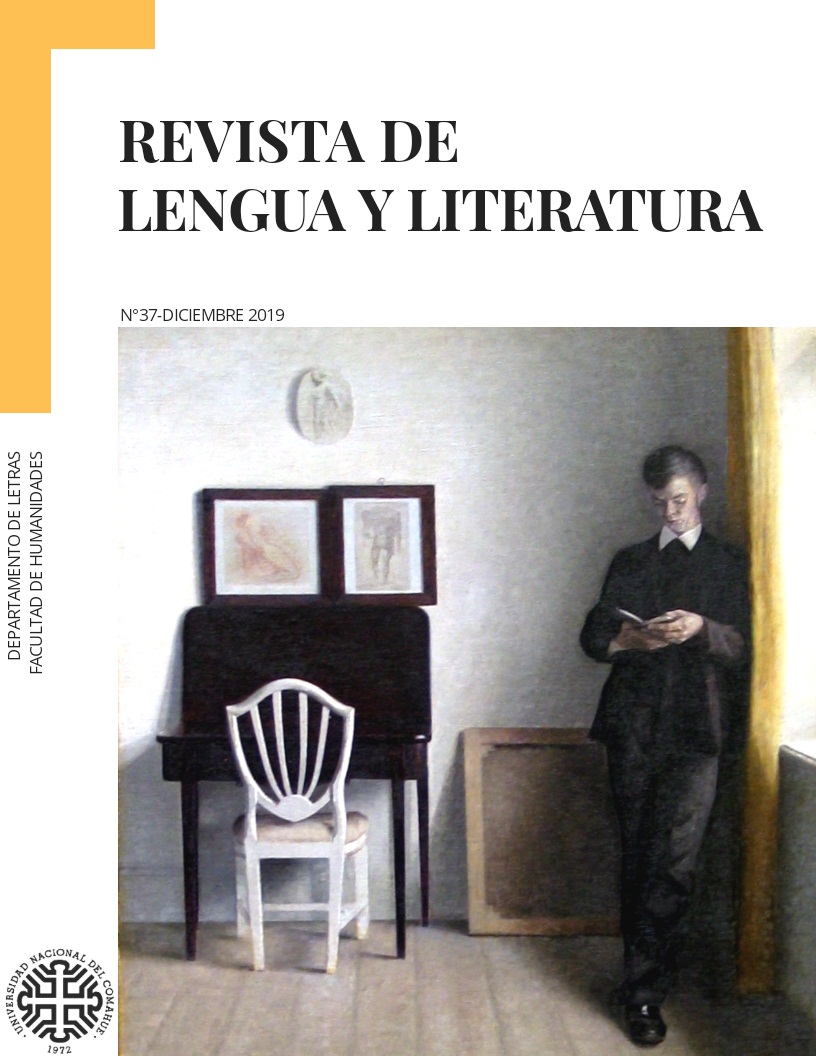El programa antisimétrico y su vigencia
Keywords:
Gramática Generativa, Antisimetría, Constituencia, ConfiguracionalidadAbstract
El programa antisimétrico formulado por Kayne en su libro The Antisymmetry of Syntax (1994) lleva veinticinco años de vigencia. En este trabajo se exploran los aspectos centrales de esta propuesta y las razones por las que esta obra se ha constituido en uno de los textos centrales de la Gramática Generativa. El foco del recorrido planteado a lo largo de estas páginas es la vinculación entre la dimensión binaria (estructura sintáctica) y la dimensión unaria (linearización) a partir del Axioma de Correspondencia Lineal (ACL). En torno a este aspecto, se revisa la manera en la que el ACL restringe, organiza y fundamenta las hipótesis sobre la estructura sintáctica. Asimismo, se propone un breve recorrido por el análisis de dos construcciones del español: una relativa a las configuraciones a nivel de estructura argumental y otra referida al funcionamiento de la concordancia. Finalmente, se dedica un espacio a la configuracionalidad de las lenguas, las discusiones en torno a este aspecto y las implicancias del programa antisimétrico para lo que se denominó el Parámetro de la configuracionalidad.Downloads
References
Alcázar, A. & M. Saltarelli. (2010). In support of a syntactic analysis of double agreement phenomena. In B. Reineke, B. Kampers-Manhe & B. Hollebrandse (eds.) Romance Languages and Linguistic Theory 2008: Selected papers from ’Going Romance’ Groningen 2008, Amsterdam, John Benjamins, pp. 1-16.
Bobaljik, J. (2008). Where’s Φ?: Agreement as a Post-syntactic Operation. En M. Van Koppen, P. Hendriks, F. Landsbergen, M. Poss & J. van der Wal (eds.). Special Issue of Leiden Papers in Linguistics 3 (2), pp. 1-23.
Brucart, J.M. & M.L. Hernanz. (2015). Las posiciones sintácticas. En Gallego, Á. (ed.) Perspectivas de sintaxis formal. Madrid: AKAL, pp. 33- 110.
Cecchetto, C. & R. Oniga. (2014). Constituency as a language universal: The case of Latin. Lingue antiche e moderne 3, pp. 5- 35.
Cinque, G. & L. Rizzi (2015). The Cartography of Syntaxtic Structures. En Heine, B. & H. Narrog (eds.) The Oxford Handbook of Linguistic Analysis. 2da. Ed. Oxford: Oxford University Press, pp. 65-78.
Chomsky, N. (1957). Syntactic Structures. The Hague: Mouton.
Chomsky, N. (1981). Lectures on Government and Binding. Dordrecht: Foris.
Chomsky, N. (1986). Barriers. Cambridge, Mass, MIT. Press.
Chomsky, N. (1995) The minimalist program. Cambridge, Mass., MIT Press.
Cinque, G. (1995). The ‘Antisymmetric’ Program: Theoretical and Typological Implications. Working Papers in Linguistics, 5, (2), pp. 1-21.
Cuervo, C. (2003). Datives at large. Tesis de doctorado, MIT.
Demonte, V. (1995). Dative alternation in Spanish. Probus 7, pp. 5-30.
Devine, A. & L. Stephens. (2006). Latin Word Order, Structured Meaning and Information, Oxford, Oxford University Press.
Evans, N. & S. Levinson. (2009). The Myth of Language Universals: Language Diversity and its Importance for Cognitive Science. Behavioral and Brain Sciences, 32, pp. 429-492.
Greenberg, J. (1966). Some Universals of Grammar with Particular Reference to the Order of Meaningful Elements, en J. Greenberg (ed.) Universals of Language, Cambridge, Mass., MIT Press, pp. 73-113.
Hale, K. (1983). Warlpiri and the grammar of non-configurational languages. Natural Language and Linguistic Theory 1, pp. 5- 47.
Harris, J. & M. Halle. (2005). Unexpected Plural Inflections in Spanish: Reduplication and Metathesis. Linguistic Inquiry, 36/ 2, 195 -222.
Hawkins, J. (1983). Word Order Universals. New York, Academic Press.
Hornstein, N, J. Nunes & K. Grohmann. (2005). Understanding Minimalism: An introduction to Minimalist Syntax. Cambridge: Cambridge University Press.
Kayne, R. (1984). Unambiguous paths. En Connectedness and binary branching. Dordrecht: Foris Publications, pp. 129-164.
Kayne, R. (1994). The Antisymmetry of Syntax. Cambridge, Massachusetts: The MIT Press.
Kayne, R. (2008). Toward a syntactic reinterpretation of Harris & Halle (2005). XXII Going Romance, University of Groningen.
Kayne, R. (2013) Why there are no directionality parameters. En Biberauer, T. & M. Sheehan (eds.) Theoretical Approaches to Disharmonic Word Order. Oxford: Oxford University Press, pp 219-244.
Larson, R. (1988). On double object construction. Linguistic Inquiry 19, pp. 335-391.
Ledgeway, A. (2012). From Latin to Romance. Morphosyntactic Typology and Change. Oxford, Oxford University Press.
Mare, M. (2018). Una nueva mirada sobre las concordancias inesperadas en español. Revista de Filología Española. XCVIII, 2º, pp. 397-422.
Masullo, P. (1992). Incorporation and the case theory in Spanish: A crosslinguistic perspective. Tesis de doctorado, Universidad de Washington.
Panhuis, D. (1982). The communicative perspective in the sentence. A study of Latin word order. Amsterdam/Philadelphia: John Benjamins.
Perlmutter, D. (1971). Deep and Surface Structure Constraints in Syntax. New York: Holt, Rinehart and Winston, New York.
Pujalte, M. (2013). Argumentos (no) agregados. Indagaciones sobre la morfosintaxis de la introducción de argumentos en español. Tesis de doctorado, UBA.
Pylkkanen, L. (2002). Introducing Arguments. Tesis de doctorado, MIT.
Reinhart, T. (1976). The syntactic domain of anaphora. Tesis de doctorado, MIT.
Rögnvaldsson, E. (1995). Old Icelandic: a non-configurational language?. NOWELE, 26, 1, pp. 3-29.
Ross, J. (1967). Constraints on Variables in Syntax. PhD. Dissertation, MIT.
Downloads
Published
How to Cite
Issue
Section
License
La aceptación de colaboraciones por parte de la revista implica la cesión no exclusiva de los derechos patrimoniales de los autores a favor del editor, quien permite la reutilización bajo Licencia Atribución-NoComercial-SinDerivadas 2.5 Argentina (CC BY-NC-ND 2.5 AR)
Usted es libre de:
Compartir — copiar y redistribuir el material en cualquier medio o formato
La licenciante no puede revocar estas libertades en tanto usted siga los términos de la licencia
Bajo los siguientes términos:
Atribución — Usted debe dar crédito de manera adecuada, brindar un enlace a la licencia, e indicar si se han realizado cambios. Puede hacerlo en cualquier forma razonable, pero no de forma tal que sugiera que usted o su uso tienen el apoyo de la licenciante.
NoComercial — Usted no puede hacer uso del material con propósitos comerciales.
SinDerivadas — Si remezcla, transforma o crea a partir
El simple hecho de cambiar el formato nunca genera una obra derivada, no podrá distribuir el material modificado.
No hay restricciones adicionales — No puede aplicar términos legales ni medidas tecnológicas que restrinjan legalmente a otras a hacer cualquier uso permitido por la licencia.





